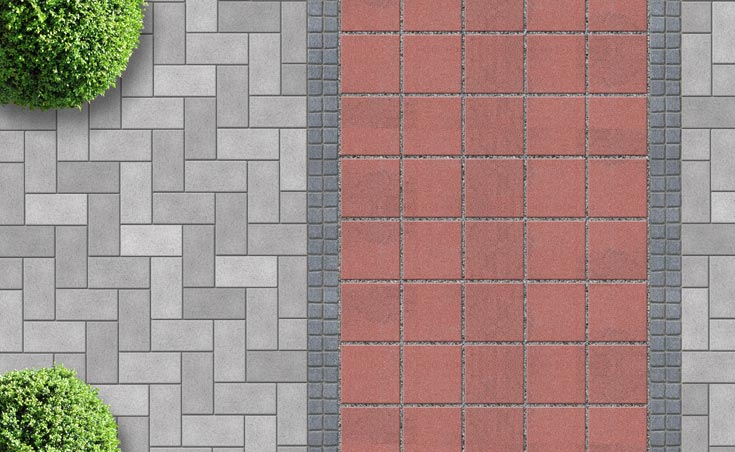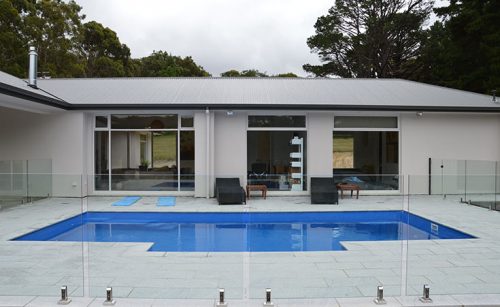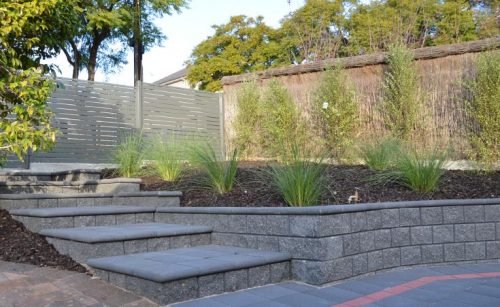When choosing pavers for outdoor living areas, such as under a verandah or around a pool, or for paving a path in your garden, there are a number of decisions you will need to make.
This article will guide you through what to consider when choosing pavers, for paving any outdoor area around your garden. You also might like to see our popular pavers page to see all the pavers we recommend from leading manufacturers.
What Area Needs To Be Paved?
We will be discussing paving 4 popular locations around the home, looking at what traffic the pavers will be taking and whether they will exposed to water so you can determine what pavers will be best for you to choose.
Pavers for Paving Under Verandas
The best pavers for paving under a verandah are large format concrete pavers that are sealed afterwards with a quality penetrating sealer. Concrete pavers come in a wide choice of colours and textures to match the theme you are wanting to create. Large format pavers; 300mm x 300mm to 450mm x 450mm, without a border will give your alfresco outdoor entertaining area a feeling of space, as will a lighter colour. Depending on how you exit from indoors to under your verandah, you may want to consider matching your paver colour to what your flooring colour is indoors; especially if you have a wide opening of glass or French doors.
Verandah pavers laid in a stack bond 45° pattern is a popular choice.Pavers for Paving Driveways
The best pavers for paving a driveway are small, square concrete pavers or rectangular brick pavers. Due to the weight of cars and light commercial trucks that will be driving up your driveway, driveway pavers should be at least 60mm thick, with 76mm thick pavers available for heavy duty performance. There are a huge range of colours to select from with clay brick pavers, but with small concrete pavers for driveways you are limited. There are many large format concrete pavers 50mm to 60mm that can be used for driveways, if you do not want to use bricks but we do not recommend them for heavy traffic situations.
Driveway pavers laid in a herringbone 90° pattern or herringbone 45° pattern with a contrasting border edge is suggested to minimise movement caused by wheels turning on your pavers.Pavers for Paving Around Pools
The best pavers for paving around pools or wet areas in general, including pavers laid as stepping stones in between a gravel path for example are large format concrete pavers. There is a huge range of colours and textures to choose from including many that emulate the look of natural stone. Matching bullnose pavers are also available for pool edging. All pavers will need to be sealed with a quality sealer periodically and bullnose pavers close to the water’s edge of a pool should be sealed underneath before laying.
Pool pavers can be laid in a pattern that suits the look you are after. Stacked bond 45° and stacked bond 90° paving patterns are the most popular paving patterns used around pools.Large format concrete pavers are also ideal for attaching pool fencing, whether you choose aluminium tubular fencing or glass panel pool fencing; available as frameless or semi frameless.
Pavers for a Path or used as Stepping Stones
The best pavers for paths around the garden including pavers laid as stepping stones are large format concrete pavers. Apart from the wide range of colours and textures concrete pavers offer, they provide non slip properties, useful for walking on when it rains, or near water features etc. Set down on a mortar base, surrounded by river pebbles with a colour of your choosing, natural stone looking concrete pavers will make a stunning path throughout your garden.
Paving Installation
There are many tricks used to lay pavers, adopted by professional paving contractors. The following process is an overview of how pavers are laid only.
Before paving anywhere around your garden, the site needs to be prepared.
Licensed paving contractors from Visual Landscape Gardening excavate the area first, taking water run-off into consideration. Depending on the slope; remembering there should be a positive fall away from your house to avoid salt damp, connecting stormwater grates to your stormwater pipes may need to be completed first.
100-150mm of quarry rubble is spread out. Some suburbs of Adelaide are well known for the ground base to contain high levels of clay; called reactive soil. If this is the case, excavation to allow for 200mm of quarry rubble is required to minimise the chance of pavers moving as the clay dries during warm weather and expands during wet weather.
Once compacted, quarry sand is spread out to the required levels and compacted ready for string lines to set up the paving lines so paving can commence.
Depending on the paving pattern you choose, some of the pavers will need to be cut before laying.
Pave-Lok is preferred to fill the gaps between the pavers to provide a flexible joint and to minimise dirt building up in the gaps. After sweeping the pavers they are compacted with either a plate compactor or for thinner pavers; 40mm or less, with a rubber mallet.Care of your Pavers
Pavers are low maintenance, but taking some preventative measures will keep the pavers you choose looking great and avoid having some replaced if care is not taken.
- All pavers should be sealed with a quality sealer. Leaves, salts, dog urine, fatty foods and red wine are common culprits that can stain un-sealed pavers.
- Sweep your pavers to keep them free of dirt and leaves with a stiff bristle outdoor broom regularly.
For more information read our article on how to maintain pavers to keep them clean and looking their best.
Adelaide Paver Prices
The price of pavers Adelaide residents can expect to pay for large format pavers ranges from the cheapest pavers at $30m² to over $100m² with many in between to choose from.
Paving Tips:
Rectangular pavers achieve maximum interlock when laid in either herringbone 45° or herringbone 90° pattern and should have a 2-3mm joint width to allow for an even laying pattern and to compact pavers without edge chipping. Pave-Lok jointing sand is also recommended to fill joints between pavers instead of sand, ensuring that if the sub base moves there will be many small ‘cracks’ between the paver and the Pave-Lok instead of a few large cracks across the pavers and a mortar.
A quarry rubble sub-base should be loosely spread in one layer of 100mm on a sandy soil base, or two layers of 75mm, forming 150mm on a clay base. In highly reactive suburbs of Adelaide, 200mm of quarry rubble will be laid. After compaction the sub-base should be at the correct level for placement of a uniform layer of quarry sand that is again compacted. Dolomite should be avoided due to its high salt content causing efflorescence on the pavers.
Efflorescence is the precipitate of fine salts and can come out of the paver or rise up with the base water. In the short term this stain can be removed with soapy water, but with rain new salt will likely be deposited. To negate this it is recommended that the pavers are sealed prior to soaking with water and that washed sand is used for the base.
Free, no obligation quotes are available for laying pavers from the paving experts – Visual Landscape Gardening.



 Courtyard Garden Makeover Unley
Courtyard Garden Makeover Unley Paving And Landscaping Adelaide
Paving And Landscaping Adelaide Pool Landscaping Heathfield
Pool Landscaping Heathfield

